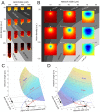Quantitative regulation of the dynamic steady state of actin networks
- PMID: 30869077
- PMCID: PMC6417862
- DOI: 10.7554/eLife.42413
Quantitative regulation of the dynamic steady state of actin networks
Abstract
Principles of regulation of actin network dimensions are fundamentally important for cell functions, yet remain unclear. Using both in vitro and in silico approaches, we studied the effect of key parameters, such as actin density, ADF/Cofilin concentration and network width on the network length. In the presence of ADF/Cofilin, networks reached equilibrium and became treadmilling. At the trailing edge, the network disintegrated into large fragments. A mathematical model predicts the network length as a function of width, actin and ADF/Cofilin concentrations. Local depletion of ADF/Cofilin by binding to actin is significant, leading to wider networks growing longer. A single rate of breaking network nodes, proportional to ADF/Cofilin density and inversely proportional to the square of the actin density, can account for the disassembly dynamics. Selective disassembly of heterogeneous networks by ADF/Cofilin controls steering during motility. Our results establish general principles on how the dynamic steady state of actin network emerges from biochemical and structural feedbacks.
Keywords: ADF/Cofilin; actin; actin disassembly; actin network length; cell biology; none.
© 2019, Manhart et al.
Conflict of interest statement
AM, TI, CG, TK, RB, MT, LB, AM No competing interests declared
Figures













Similar articles
-
Architecture dependence of actin filament network disassembly.Curr Biol. 2015 Jun 1;25(11):1437-47. doi: 10.1016/j.cub.2015.04.011. Epub 2015 Apr 23. Curr Biol. 2015. PMID: 25913406
-
Determining the differences in actin binding by human ADF and cofilin.J Mol Biol. 2002 Jan 25;315(4):911-25. doi: 10.1006/jmbi.2001.5280. J Mol Biol. 2002. PMID: 11812157
-
Cofilin/ADF is required for cell motility during Drosophila ovary development and oogenesis.Nat Cell Biol. 2001 Feb;3(2):204-9. doi: 10.1038/35055120. Nat Cell Biol. 2001. PMID: 11175754
-
Control of actin dynamics in cell motility.J Mol Biol. 1997 Jun 20;269(4):459-67. doi: 10.1006/jmbi.1997.1062. J Mol Biol. 1997. PMID: 9217250 Review.
-
Cellular functions of the ADF/cofilin family at a glance.J Cell Sci. 2016 Sep 1;129(17):3211-8. doi: 10.1242/jcs.187849. Epub 2016 Aug 9. J Cell Sci. 2016. PMID: 27505888 Review.
Cited by
-
Reconstituted systems for studying the architecture and dynamics of actin networks.Biochem J. 2025 May 23;482(11):691-708. doi: 10.1042/BCJ20253044. Biochem J. 2025. PMID: 40411213 Free PMC article. Review.
-
Fascin-induced bundling protects actin filaments from disassembly by cofilin.J Cell Biol. 2024 Jun 3;223(6):e202312106. doi: 10.1083/jcb.202312106. Epub 2024 Mar 18. J Cell Biol. 2024. PMID: 38497788 Free PMC article.
-
Intra-bundle contractions enable extensile properties of active actin networks.Sci Rep. 2021 Jan 29;11(1):2677. doi: 10.1038/s41598-021-81601-0. Sci Rep. 2021. PMID: 33514794 Free PMC article.
-
A mechanism with severing near barbed ends and annealing explains structure and dynamics of dendritic actin networks.Elife. 2022 Jun 7;11:e69031. doi: 10.7554/eLife.69031. Elife. 2022. PMID: 35670664 Free PMC article.
-
Optogenetic actin network assembly on lipid bilayer uncovers the network density-dependent functions of actin-binding proteins.Nat Commun. 2025 Aug 26;16(1):7583. doi: 10.1038/s41467-025-62653-6. Nat Commun. 2025. PMID: 40858537 Free PMC article.
References
Publication types
MeSH terms
Substances
Grants and funding
LinkOut - more resources
Full Text Sources
Research Materials

